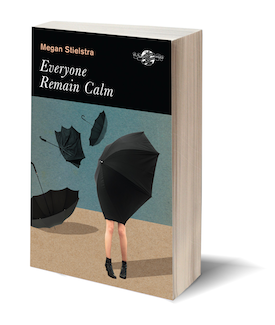Everyone Remain CalmBy Megan Stielstra
Joyland/ECW Press |
 |
|---|
Reviewed by Shawn Syms
"I know I make a lot of shit up for these stories but that's the God's honest truth." This sentence neatly encapsulates the tension between constructed narrative and documentary truth that characterizes Megan Stielstra's debut collection, Everyone Remain Calm.
Many lines blur in this book, including those between fiction and personal essay and between the literal and the fantastic. Some stories appear to be memoir rather than fiction, based on cues that include mentions of Stielstra's husband by name and subject matter seemingly culled from her life history, such as the travails of a creative-writing instructor. Then again, one story that commences ostensibly as creative non-fiction ends with a fifty-person marching band that follows the author all the way from New Orleans to her Midwestern hometown.
The effect of these juxtapositions is pleasingly disorienting. First-person narratives dominate Everyone Remain Calm, and the reader experiences uncertainty at every story's outset as to which aspects of the carefully constructed episodes are factual and which are invented.
Chicago—its streets, bars, transit system and, particularly, its weather—features prominently. The title story has its climax in April—storm season in the city. In "Everyone Remain Calm," a young woman battles an ongoing anxiety disorder after her mother's death in a violent tornado. The resultant phobia—a panic about wind itself—has a long-lasting effect on the narrator and all her romantic relationships. Joe, the deadbeat dad in "The Flood," shows up on his ex's Logan Boulevard doorstep to see their son every time it snows. After a dozen years without a flake, he returns along with a blizzard. In the intervening years, the woman has changed dramatically, but he has not. To banish him, she wills up thunderclouds and conjures a snow-melting rainstorm to rival Noah's.
Across the eighteen short pieces in this collection, Stielstra's highly energetic prose enlivens her curious, passionate and frequently angry female protagonists. In the first story, "Shot to the Lungs and No Breath Left," fifteen-year-old Shannon is sucker-punched by her roughneck boyfriend Wade. Surrounded by her male relatives in their remote Alaskan town, she holds a bag of frozen peas over her "left eye, the eye that two hours before had swallowed Wade's fist in a single gulp, knuckle bone on skull bone and everything went black."
Her dad intends to extract vengeance using a .375 Holland and Holland Magnum, and she imagines the scene vividly:
Suddenly—a hard, fast whack to the chest, so fast he's not sure at first if it actually happened. He opens his mouth to speak but his breath is locked so he can't get out the words, just two hollow gulps of air before his lungs soak red like a wet sponge and slowly, slowly, blood seeps through the canvas of his coveralls. In one fatal, horrible second everything connects: the dark red-brown staining his chest. The airless gasping like some cancer patient with a cigarette.
Shannon loves her father but feels ambivalent about his protective impulses. Raised by men after her mother left, she thrives in the testosterone-heavy environment, successfully shooting down caribou in the wild from the age of eight. Her remaining family members ridicule any impulse at all toward femininity, while the hard-edged Wade validates her desirability as a girl. This opener introduces a number of themes that recur throughout the book: parental abandonment, dating as problematic and risky, and the ominous and persistent threat of male violence.
In "One One-Thousand, Two One-Thousand, Three," adolescent Eliza swims nude in an isolated pond imagining the arrival of an archetypal Mr. Someone. A throng of aggressive young males show up instead, determined to see her naked. The series of events that follow are deeply disturbing, but when one of the boys defends her and the others eventually depart, Eliza discovers she's happy to present her exposed body to him.
Female sexual autonomy is also front and center in "I Am the Keymaster." Its plain-spoken narrator, who works as a minimum-wage key-cutter at a hardware store, often fantasizes that she can use keys to resolve difficult situations or unlock emotional truths. When she needs the Pill after an abortion but just can't afford it, her plan to get black-market contraception via Craigslist goes horribly awry. Still, she asserts, "I will not be held back!" —and proves it. Backed by a throng of women in the same predicament, she leads a midnight march to a locked-up birth-control clinic to get her reproductive needs met by any means necessary.
Everyone Remain Calm is a daring and inventive debut. Stielstra's use of language, while dynamic, is focused and unexperimental—plot is where she exercises her flair for innovation. The developments that unfold in these eighteen stories are consistently imaginative and unexpected (one character has athletic rebound sex with The Incredible Hulk!). While dating and male/female relationships are well-worn literary territory, Stielstra breathes fresh life into such otherwise familiar subjects.
